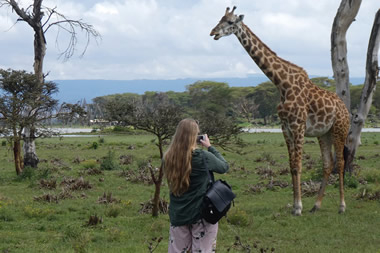Sometimes referred to as bush walk, or nature walk, a walking safari is a safari on foot.
Walking safari in Africa offers a different kind of experience – an immersive and thrilling experience. They offer a unique opportunity to intimately connect with the continent’s untamed wilderness.
However, as with any kind of adventure, safety and security should be a top priority.
In this blog article, we will delve into the security and safety aspects of a walking safari in Africa. The article will hopefully give you insights and tips to ensure a secure and memorable walking safari experience.
What makes Walking Safaris Safe and Secure?
On a walking safari we fully appreciate the finer details of the bush, from the hard-working dung beetle to majestic trees.
Look out for the spoor and tracks of animals, stop to smell the plants, and take your time to admire the smaller and often unnoticed animals.

Expert Guided Safaris
One of the key factors ensuring safety on a walking safari is the presence of experienced and knowledgeable safari guides. These experts possess in-depth understanding of the local wildlife, behavior patterns, and the environment. They are trained in tracking, assessing potential risks, and ensuring the safety of guests. Opt for reputable safari operators that employ certified guides with a proven track record of providing safe and enriching walking safaris.
Pre-Walking Safari Briefings
Before embarking on a walking safari, reputable operators conduct comprehensive pre-safari briefings. These briefings cover safety protocols, wildlife behavior, and instructions on how to maintain a safe distance from animals. Guides educate participants on how to read animal signs, recognize potential dangers, and conduct themselves appropriately in the wilderness. Following these safety measures and instructions is crucial for a secure walking safari experience.
Small Group Size & Close Monitoring
Walking safaris are typically conducted in small groups, allowing for personalized attention and close monitoring by guides. Smaller groups facilitate better communication, enable guides to focus on individual guests, and ensure everyone’s safety during encounters with wildlife. Guides maintain a watchful eye on the surroundings, tracking animal movements and ensuring that participants maintain a safe distance from potentially dangerous wildlife.
Maintaining A Respectful Distance
While walking safaris provide an up-close and personal experience with wildlife, it’s important to maintain a respectful distance to ensure safety for both humans and animals. Guides adhere to strict guidelines regarding proximity to wildlife and instruct participants on how to move quietly, avoid sudden movements, and respect the animals’ space. By maintaining distance and not interfering with natural behaviors, the risk of dangerous encounters is significantly minimized.
Understanding Animal Behaviour
An essential aspect of a safe walking safari is understanding animal behavior and recognizing signs of potential threats. Guides share their expertise on reading animal behavior, identifying warning signs, and assessing the situation to make informed decisions. By being attentive to the guidance of the experienced guides, participants can mitigate risks and enjoy wildlife encounters with confidence.
Terrain & Environmental Awareness
Walking safaris take place in diverse ecosystems, including savannahs, forests, and wetlands. Guides are well-versed in assessing terrain conditions and ensuring participants navigate safely through the landscape. They educate guests about potential hazards such as uneven terrain, slippery surfaces, or encounters with venomous insects or snakes. Environmental awareness and attentiveness to the surroundings contribute significantly to a safe walking safari experience.
Communication & Emergency Preparedness
Reputable safari operators maintain reliable communication systems, including radios or satellite phones, to stay connected with other guides, camps, and emergency services. Guides are trained in first aid and wilderness survival skills, ensuring they are prepared to handle any unforeseen situations. Participants are briefed on emergency procedures, including protocols for encountering dangerous animals, ensuring that everyone is equipped to respond calmly and effectively if the need arises.
Responsible Tourism and Conservation
Responsible tourism practices play a crucial role in ensuring safety on walking safaris. Operators that prioritize conservation efforts, maintain sustainable practices, and collaborate with local communities contribute to a safer environment for both wildlife and visitors. Supporting ethical and responsible operators reinforces the preservation of natural habitats and fosters harmonious coexistence between humans and animals.
Conclusion:
A walking safari in Africa can be an awe-inspiring and safe adventure when conducted with reputable operators and experienced guides. With expert guidance, adherence to safety protocols, and understanding of animal behavior, participants can explore the wilderness with peace of mind.
By choosing responsible operators and prioritizing conservation efforts, travelers contribute to the preservation of Africa’s wildlife and habitats. So, lace up your boots, embrace the magic of a walking safari, and create unforgettable memories in the heart of Africa’s untamed wilderness, knowing that your safety is a top priority.

